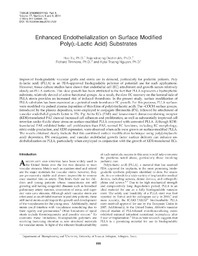
ATTENTION: The works hosted here are being migrated to a new repository that will consolidate resources, improve discoverability, and better show UTA's research impact on the global community. We will update authors as the migration progresses. Please see MavMatrix for more information.
Show simple item record
| dc.contributor.author | Nguyen, Kytai Truong | |
| dc.contributor.author | Xu, Hao | |
| dc.contributor.author | Timmons, Richard B. | |
| dc.contributor.author | Deshmukh, Rajendrasing | |
| dc.date.accessioned | 2014-08-02T23:27:14Z | |
| dc.date.available | 2014-08-02T23:27:14Z | |
| dc.date.issued | 2011 | |
| dc.identifier.citation | Published in Tissue Engineering: Part A Volume 17 Numbers 5 and 6, 2011 | en_US |
| dc.identifier.issn | 1937-3368 | |
| dc.identifier.uri | http://hdl.handle.net/10106/24519 | |
| dc.description | This is a copy of an article published in the Tissue Engineering Part A ©2011[copyright Mary Ann Liebert, Inc.]; Tissue Engineering Part A is available online at: http://online.liebertpub.com. | en_US |
| dc.description.abstract | **Please note that the full text is embargoed** ABSTRACT: Improved biodegradable vascular grafts and stents are in demand, particularly for pediatric patients. Poly (L-lactic acid) (PLLA) is an FDA-approved biodegradable polymer of potential use for such applications. However, tissue culture studies have shown that endothelial cell (EC) attachment and growth occurs relatively slowly on PLLA surfaces. This slow growth has been attributed to the fact that PLLA represents a hydrophobic substrate, relatively devoid of active functional groups. As a result, the slow EC recovery on the luminal side of PLLA stents provides an increased risk of induced thrombosis. In the present study, surface modification of PLLA substrates has been examined as a potential route to enhance EC growth. For this purpose, PLLA surfaces were modified via pulsed plasma deposition of thin films of poly(vinylacetic acid). The -COOH surface groups, introduced by the plasma deposition, were employed to conjugate fibronectin (FN), followed by attachment of vascular endothelial growth factor to FN. Pig Aorta ECs (PAE) and kinase-insert domain-containing receptor (KDR)-transfected PAE showed increased cell adhesion and proliferation, as well as substantially improved cell retention under fluidic shear stress on surface-modified PLLA compared with untreated PLLA. Although KDR-transfected PAE exhibited better cell proliferation than PAE, normal EC functions, including EC morphology, nitric oxide production, and KDR expression, were observed when cells were grown on surface-modified PLLA. The results obtained clearly indicate that this combined surface modification technique using poly(vinylacetic acid) deposition, FN conjugation, and vascular endothelial growth factor surface delivery can enhance endothelialization on PLLA, particularly when employed in conjunction with the growth of KDR-transfected ECs. | en_US |
| dc.description.sponsorship | We acknowledge the support from the NIH (HL082644: K.N.) and UTA Research Area Enhancement grants. | en_US |
| dc.language.iso | en_US | en_US |
| dc.publisher | Mary Ann Liebert | en_US |
| dc.subject | Poly (L-lactic acid) (PLLA) | en_US |
| dc.subject | Endothelial cell (EC) attachment and growth | en_US |
| dc.subject | Vascular stenosis | en_US |
| dc.subject | Angioplasty | en_US |
| dc.subject | Stenting | en_US |
| dc.title | Enhanced endothelialization on surface modified poly(l-lactic acid) substrates | en_US |
| dc.type | Article | en_US |
| dc.publisher.department | Department of Bioengineering, The University of Texas at Arlington | en_US |
| dc.identifier.doi | http://dx.doi.org/10.1089/ten.tea.2010.0129 | |
Files in this item
- Name:
- Nguyen_2011_Tissue_Eng_Pt_A.pdf
- Size:
- 4.522Mb
- Format:
- PDF
- Description:
- PDF
This item appears in the following Collection(s)
Show simple item record


